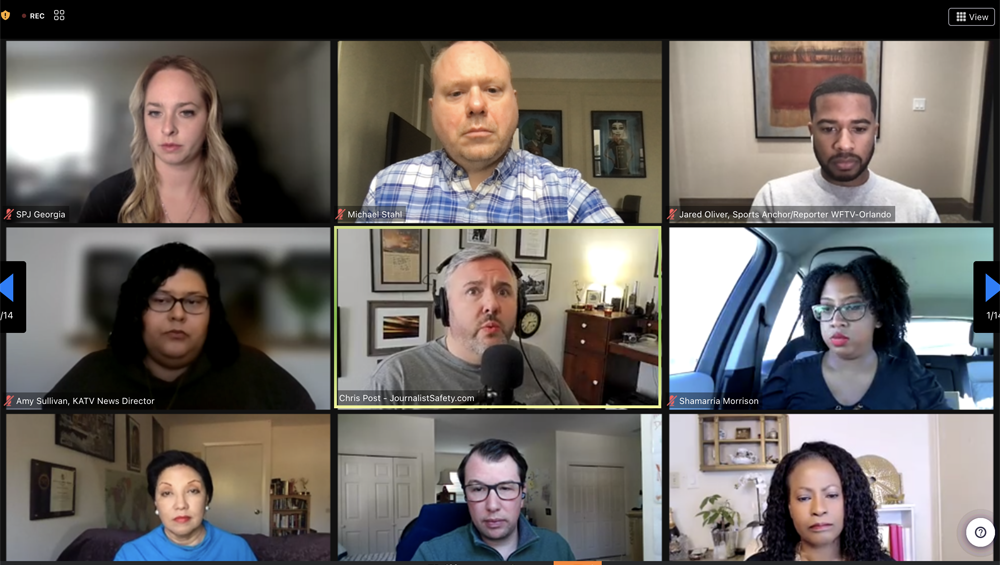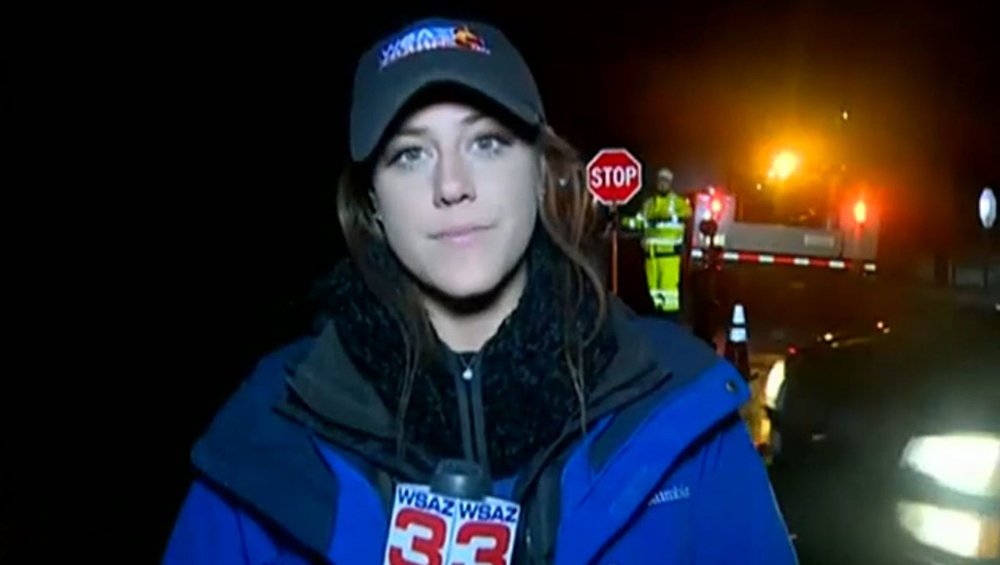
MMJs Sound Off On Safety In Town Hall

During last year’s U.S. Capitol insurrection, CNN attorney Drew Shenkman took an urgent call from a network field reporter, out on his own, who’d just witnessed some of the first rioters jump over outer area barricades and run toward the congressional home. The journalist asked Shenkman if he should report from closer to the growing mob or even from inside the Capitol.
“My first question to him wasn’t anything related to legal advice, it was, ‘What do you want to do?’ ” said Shenkman last Saturday during a virtual panel discussion about multimedia journalist safety, organized by the Society of Professional Journalists (SPJ). The reporter told Shenkman he didn’t feel safe proceeding toward the scene and would find a security guard to join him before possibly doing so.
“I said, ‘That’s a great idea,’ ” Shenkman continued. “Letting the person on the other end of that phone call … guide what is happening on the ground is really critical.”
The safety of reporters, particularly “one-man band” multimedia journalists (MMJs) who report, shoot and file stories from the field without the assistance of any other colleagues, is at the forefront of seemingly everyone’s mind in TV news these days.
On Jan. 19, a young MMJ in West Virginia named Tori Yorgey was struck by a car while conducting a stand-up about a water main break during an evening newscast. Fortunately, save for some soreness she later experienced, Yorgey was unharmed. She even continued with her report, returning the camera to its upright position after it was knocked over, and repeatedly told viewers, the anchor and even the driver that she was not hurt.

WSAZ’s Tori Yorgey
“My life just flashed right before my eyes, but this is live TV and everything’s OK,” she said just seconds after the car hit her from behind.
While many journalists praised Yorgey’s resilience on social media, the alarming broadcast also sparked widespread industry conversation about the prioritization of MMJ safety. For many, the increase in MMJ presence marks newsgroups’ cutting of financial corners — why hire a photographer when reporters can shoot themselves?
“I can’t stop thinking about how with a photographer there, it’s likely they would’ve seen that car coming and warned her or pulled her out of the way,” tweeted anchor Deanna Allbrittin, along with an embed of the Yorgey video. “This could BE so many MMJs. Again. Today.”
Yorgey herself has since called the incident “a freak accident,” and remarked that she’d position herself in the same spot again even in retrospect. Still, the industry remains abuzz about what could have prevented the incident and how news teams can keep it from happening again to other reporters. Saturday’s SPJ town hall-style discussion was a chance for a few insiders to sound off.
“My first thought was, ‘Why didn’t they cut the video?’” said Amy Sullivan, news director at KATV Little Rock, AR. “[I was] also wondering why she was outside, alone, in the dark. It just doesn’t make any sense to me, for a water main break.”
Others echoed these same takeaways.
Jared Oliver, a sports reporter and anchor at Orlando’s WFTV, said that newsroom operators are often on “auto pilot,” though he empathetically implied that the demands that come with a 24-hour news cycle may contribute to their general malaise and consequential disregard for reporter safety.
“If there’s breaking news … you want to be first, you want to be accurate, but also: Do you want to put our employee in jeopardy?” Oliver said. “You just have to consider people’s well-being a lot [more] of the time.”
Panel members also pointed out that field reporters, particularly MMJs, should undergo extensive training, facilitated by their employers, before ever filing their first stories, to help keep them safe.
“Things like situational awareness are super important,” said Chris Post of JournalistSafety.com, an international media support group that, among other services, offers safety training to reporters. “But unless you have been in the military or were in public safety or something like that, you probably never had anybody talk to you about situational awareness and how to be proactive versus being reactive when things occur and reading the environments around you.”
Post conceded that situational awareness training alone wasn’t enough to keep all MMJs safe. Broad “safety education,” he said, must be required, especially today when “journalists are being targeted.” One of the many steps field reporters can take to help ensure their safety, Post said, is to turn on the locator feature that many smartphones have and grant their news director access to it.
“Poof, all of a sudden they know exactly where you are, unless your phone is damaged or destroyed,” Post said. “Stations should think about other things they can do.”
Another conversational focus centered around the pressure on journalists to deliver, which might impede them from advocating for themselves in moments when they feel unsafe. It’s one thing for news directors and other executives to say safety comes first; it’s another to have a newsgroup culture that truly embraces such a message and has aligned expectations with that approach.
Sherry Darden, a consultant who helps businesses create positive and productive work environments, said for employees, “We need to let people know when we’re not OK: ‘I’m hurt, I’m scared, I don’t feel comfortable.’”
In her mind, when Yorgey said she was “fine” after getting hit by the car, it was a moment in which she was running on adrenaline, and there was every chance that deep-rooted career pressures influenced her to say as much and carry on with the report.
“As MMJs we have to put a mind on what we will and will not tolerate,” said Shamarria Morrison, an MMJ at WCNC Charlotte, who volunteered that, like Yorgey, she is on the younger side of the spectrum, with less than five years of experience. “At the end of the day, you don’t want to be at a station [that] doesn’t respect your safety.”
She said a prime reason she works for WCNC is because the “newsroom culture” there was already “within my lines” of what she considered reasonable safety expectations.
“You have to have those clear lines and know that — this is cliché — [but] if you stand for nothing, you’ll fall for anything and everything,” Morrison said.
“You set the tone at the interview because if they put us out there to get the goods … then we should be able to use that energy, that voice, that strength inside the newsroom,” said SPJ President Rebecca Aguilar, who also moderated the discussion. “If you have a voice, use it.”



































Comments (2)
tvn-member-4225652 says:
January 31, 2022 at 11:06 am
I am a huge supporter of the MMJ model. In fact we started at the NBC Station group all the way back in 2005. Later in my career we rolled out at the Univision TV Station group in 2013. It works, but there are conditions that need to be met in order for it to be as safe as possible. In the article, you talk about awareness training for the MMJ Field crews. Yes that is critical, valuable training. However the awareness training starts with the Newsroom. From the executives all the way through the room and most importantly the assignment desk or whatever model you follow for assigning stories. These are the employees who need to understand the difference between the crews and what you are asking of them. The number one priority should always be to use care/street sense/caution when making assignments. Until this is understood by all, you put your TV Station at risk for a possible bad situation.
While the MMJ model does save operational costs, it should never be looked at as a way to save capital (equipment, technology) money. Investments should be ongoing to improve safety, buy lighter equipment and deploy the easiest technology for an MMJ to use. The MMJ crews should have the latest and the best equipment.
The MMJ model works and works well when properly deployed. There are many stories and scenarios that lend themselves to an MMJ crew covering while staying safe in the process. Some of the best story telling I have seen during the pandemic has come from MMJs.
Lastly, to the newsrooms using MMJs. When you speak with your MMJ crews….listen, respect their feedback from the field, know they are on the scene, you are in the newsroom, do not make assumptions about how it should be, trust your crews they are trying to please you and always keep the communication open. It all adds up to success for everyone!
tvn-member-1865313 says:
February 1, 2022 at 3:09 pm
Many thanks to the Society of Professional Journalists (SPJ) for undertaking this critical educational task. Far too many MMJs are young, inexperienced journalists who have yet to encounter dangerous situations and being equipped with better training is one way to help reduce the potential problems that can accompany “working solo.” Further, management must accept its responsibility to provide those who work in the field with the necessary safeguards to keep them from situations which could be harmful.
It’s my fervent hope that more journalism organizations step up to the plate on this very important issue.
Mike Cavender
Executive Director Emeritus
RTDNA